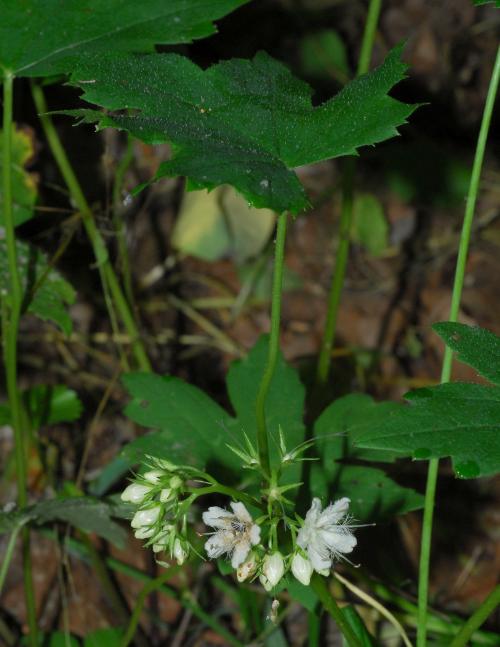Hydrophyllum canadense L.
Broadleaf Waterleaf

Native
CC = 7
CW = 0
MOC = 15
© SRTurner
Hydrophyllum canadense L.Broadleaf Waterleaf | |
 |
Native CC = 7 CW = 0 MOC = 15 |
© SRTurner |
|
Family - Hydrophyllaceae Habit - Perennial forb, with scaly, usually long rhizomes, often forming large colonies. Stem - Ascending, to 50 cm, nearly glabrous to sparsely pubescent with stiff, spreading to downward-curved hairs.
Leaves - Basal and alternate. Basal leaves with the blade 10-27 cm long, oblong to broadly elliptic in outline, pinnately deeply lobed with 7-11 lobes, these truncate or slightly narrowed at the base, the margins coarsely toothed, the surfaces sparsely pubescent with, stiff, straight hairs, the upper surface often mottled, the undersurface often nearly glabrous. Stem leaves with the blade 5-30 cm long, broadly ovate to nearly circular in outline, more or less palmately and shallowly to moderately lobed, the 5-9 lobes tapered from the broad base, the pubescence similar to that of the basal leaves.
Inflorescence - Compact clusters, irregularly branched and sometimes slightly scorpiod. Inflorescences usually positioned beneath the stem leaves.
Flowers - Calyces 3-7 mm long, the lobes bristly-hairy along the margins and on the outer surface toward the base, the sinuses lacking appendages. Corollas 7-11 mm long, bell-shaped to broadly bell-shaped, white to lavender or purplish tinged. Stamens and style exserted 3-5 mm beyond the corolla. Single pistil of 2 fused carpels. Ovary unilocular.
Fruits - Globose capsules, 3-4 mm, hairy, 1-3 seeded.
Flowering - May - July. Habitat - Mesic and bottomland forests, bases of bluffs. Origin - Native to the U.S. Lookalikes - H. appendiculatum. Other info. - Dense vegetative carpets of this species are not uncommon in rich bottomlands; however, differentiation from H. appendiculatum is difficult unless fertile material is present. Because the flowers are borne beneath the leaf canopy, they are often missed at a casual glance. The basal leaves will persist throughout the growing season if the ground is kept moist, making an attractive native ground cover for shaded garden areas. According to Steyermark, the young foliage can be cooked and eaten. Photographs taken at Washington State Park, Washington County, MO, 4-24-2017, Little Lost Creek Conservation Area, Warren County, MO, 6-6-2018, and Engelmann Woods Natural Area, Franklin County, MO, 8-6-2021 (SRTurner). |